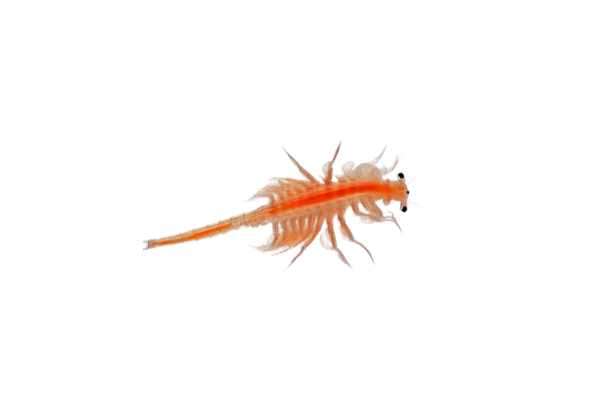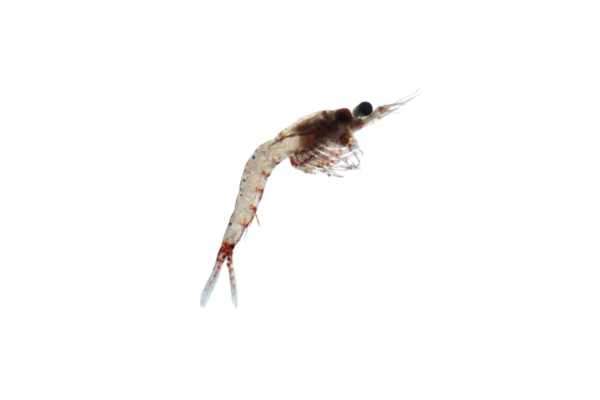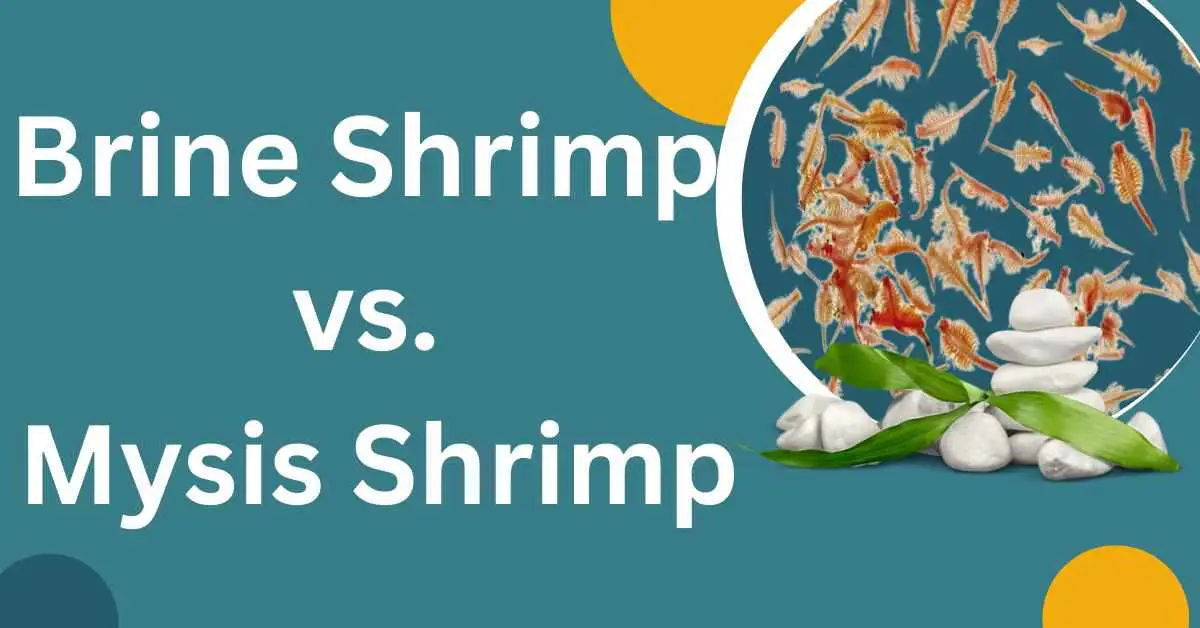Hey there, fellow aquarium enthusiast! Let’s dive into the exciting world of aquatic nutrition and discover the best food choices for our underwater buddies. In this article, we’ll explore the two rockstars of the fish food scene: Brine Shrimp and Mysis Shrimp. These tiny crustaceans have gained quite a reputation as go-to options for our finned friends.
As aquarium caretakers, we know how crucial it is to provide the right nourishment for our fishy pals. So, join us on this adventure as we uncover the fascinating details of Brine Shrimp and Mysis Shrimp, their nutritional goodness, and the age-old debate between live and frozen varieties. Ready to make some waves of fishy excitement? Let’s get started!
What is Brine Shrimp ?
Brine shrimp, scientifically known as Artemia, are small, aquatic crustaceans found in salty waters across the globe. Their life cycle is fascinating, with an ability to produce dormant eggs known as cysts, which can withstand extreme environmental conditions. These cysts hatch into nauplii, the first larval stage of brine shrimp, which eventually develop into fully grown adults. This remarkable ability to survive harsh conditions has made them a popular choice as aquarium fish food.

Brine Shrimp
The nutritional value of brine shrimp is a significant factor to consider when feeding your aquatic pets. These tiny creatures pack a punch of nutrients, providing essential proteins, lipids, and carbohydrates that support the growth and vitality of your fish.
Advantages of Feeding Brine Shrimp
One significant advantage of feeding brine shrimp is their cost-effectiveness and availability. These tiny crustaceans are widely produced and can be found in various forms, including live, frozen, and even as dry flakes or pellets.
Brine shrimp are particularly suitable for young and small fish due to their small size and easy-to-digest nature. Additionally, feeding brine shrimp can encourage natural hunting behavior in predatory fish, stimulating their instincts and keeping them active and engaged.
Drawbacks of Feeding Brine Shrimp
While brine shrimp have their benefits, it’s essential to acknowledge their limitations. One notable drawback is their limited nutritional value compared to other options like mysis shrimp. While they can serve as a supplemental diet, relying solely on brine shrimp might not provide all the necessary nutrients for your fish’s long-term health.
Another concern with brine shrimp is the possibility of disease transmission. Live brine shrimp, in particular, can carry pathogens that may harm your fish if not sourced from reputable suppliers.
Additionally, brine shrimp have a short shelf life and can be challenging to store for extended periods. Ensuring a constant supply of live brine shrimp may require consistent efforts in maintaining a brine shrimp culture.
Live Brine Shrimp vs. Frozen Brine Shrimp
Now that we have explored the advantages and drawbacks of brine shrimp, let’s delve into the debate between live and frozen options.
Feeding live brine shrimp can offer several benefits to your fish. Live prey stimulates their natural hunting instincts, promoting a more active and engaged environment. Moreover, live brine shrimp have a higher nutritional value compared to their frozen counterparts, as freezing may lead to nutrient loss over time.
On the other hand, frozen brine shrimp offer convenience and ease of storage. They can be readily thawed and served to your fish without the hassle of maintaining a live brine shrimp culture. Additionally, frozen brine shrimp retain their nutritional value better than dried alternatives.
Best practices for feeding both live and frozen brine shrimp include ensuring the shrimp are appropriately sized for your fish and offering them as part of a diverse and balanced diet.
How to Culture Brine Shrimp at Home
If you’re considering incorporating live brine shrimp into your aquarium’s diet, you might want to try culturing them at home. Culturing brine shrimp can be a rewarding and cost-effective way to provide a steady supply of this nutritious food source.
To set up a brine shrimp culture, you’ll need a container, a source of brine shrimp cysts, and a suitable saltwater solution. The process involves hatching the cysts into nauplii, which can then be harvested and fed to your fish.
During the harvesting and feeding procedures, it’s crucial to ensure the proper separation of nauplii from the unhatched cysts and debris. This can be achieved using a brine shrimp net or a fine-meshed sieve.
Maintaining a sustainable brine shrimp culture requires regular attention to water quality, temperature, and feeding. By following best practices, you can ensure a consistent and healthy supply of live brine shrimp for your aquarium inhabitants.
What is Mysis Shrimp ?
Mysis shrimp, also called opossum shrimp or mysidacea, are small shrimp-like crustaceans typically found in both saltwater and freshwater environments. In their natural habitat, they serve as a vital link in the food chain, providing nourishment to various marine and freshwater species.

Mysis Shrimp
When it comes to nutritional composition, mysis shrimp boast an impressive profile that caters to the specific dietary requirements of your aquarium inhabitants. Rich in proteins, fats, and other essential nutrients, mysis shrimp can significantly contribute to the overall health of your fish.
Advantages of Feeding Mysis Shrimp
Mysis shrimp, with their superior nutritional profile, offer an excellent option for fish with specific dietary preferences. If you have finicky or picky eaters in your aquarium, mysis shrimp might be the key to enticing them with a delectable and nutritious meal.
Furthermore, mysis shrimp are known to contain a compound called “thiaminase,” which aids in boosting the fish’s immune system. This can lead to overall healthier and more robust fish populations in your tank.
Drawbacks of Feeding Mysis Shrimp
Mysis shrimp come with a couple of drawbacks as well. Their higher cost compared to brine shrimp can be a concern for some aquarium owners, especially those with larger fish populations to feed.
Additionally, not all fish species are suitable for a mysis shrimp diet. Some fish may not be able to consume mysis shrimp due to their size or specific dietary requirements. Therefore, it’s essential to research your fish species’ dietary preferences before committing to mysis shrimp as the primary food source.
Moreover, the harvesting of wild mysis shrimp for the aquarium trade can raise potential environmental concerns. Sustainable aquaculture practices and responsible sourcing can help mitigate these issues.
Live Mysis Shrimp vs. Frozen Mysis Shrimp
Similar to brine shrimp, the choice between live and frozen mysis shrimp presents its own set of considerations.
Feeding live mysis shrimp can be particularly beneficial for picky eaters. The live movement of the prey can entice even the most reluctant fish to feed.
However, maintaining a live mysis shrimp culture can be challenging and time-consuming. This option requires careful attention to water quality, temperature, and proper feeding of the culture.
On the other hand, frozen mysis shrimp provide a more accessible and convenient option for aquarium owners. They can be easily stored in the freezer and thawed when needed, ensuring a constant supply of nutritious food for your fish.
To ensure nutrient retention in frozen mysis shrimp, it’s essential to avoid overcooking during the thawing process. A gentle and gradual thawing method is recommended to preserve the shrimp’s nutritional value.
How to Culture Mysis Shrimp at Home
If you’re interested in cultivating live mysis shrimp, a similar approach can be taken to set up a home culture.
To establish a mysis shrimp culture, you’ll need a container with suitable water conditions, aeration, and a light source to stimulate algae growth. Mysis shrimp thrive on a diet of algae and microorganisms, which can be cultivated in the culture container.
During harvesting and feeding, it’s essential to separate the mysis shrimp from their culture medium to ensure your fish receive the maximum nutritional benefit.
Overview Comparison: Brine Shrimp vs. Mysis Shrimp
Here’s a comparison table highlighting the key differences between Brine Shrimp and Mysis Shrimp:
| Aspect | Brine Shrimp | Mysis Shrimp |
| Scientific Name | Artemia | Mysis diluviana (Common name: opossum shrimp) |
| Habitat | Salty waters worldwide | Both saltwater and freshwater environments |
| Life Cycle | Cysts hatch into nauplii larvae | Direct development, no larval stage |
| Nutritional Composition | Good protein, limited nutritional value | High protein, fats, and essential nutrients |
| Advantages | Cost-effective and readily available | Superior nutritional profile, immune boost |
| Suitable for | Young and small fish | Picky eaters, various fish species |
| Hunting Behavior | Promotes natural hunting instincts | Entices even reluctant eaters |
| Drawbacks | Limited nutritional value, disease risks | Higher cost, limited suitability for some |
| Storage and Shelf Life | Short shelf life, challenging to store | Can be frozen for longer shelf life |
| Culturing at Home | Relatively easy to culture at home | Requires more attention and effort |
| Environmental Impact | Sustainable, environmental concerns | Sustainable practices needed for sourcing |
| Feeding Frequency | Regular feeding required | Regular feeding required |
| Water Quality Impact | Moderate waste production | Moderate waste production |
| Allergic Reactions | May cause allergies in some fish | May cause allergies in some fish |
| Community Tank Compatibility | Suitable for community tanks | Suitable for community tanks |
| Saltwater vs. Freshwater Use | Suitable for freshwater and marine tanks | Suitable for both freshwater and marine |
| Specialized Species Consideration | Some fish may not accept as a sole diet | Ideal for specific dietary needs |
Comparison of Nutritional Content: Brine Shrimp Vs. Mysis Shrimp
Both Brine Shrimp and Mysis Shrimp offer valuable nutrition for our aquatic friends, the specific dietary needs of different fish species can vary. Depending on the types of fish you have in your tank, you might find that one shrimp variety better suits their nutritional requirements. As responsible aquarium caretakers, observing your fish’s health and behavior will guide you in selecting the ideal diet that keeps them swimming happily!
Let’s take a closer look at the nutritional content of both Brine Shrimp and Mysis Shrimp to see what these tiny creatures have to offer for our fishy friends:
| Nutritional Content | Brine Shrimp | Mysis Shrimp |
| Protein Levels | Good source of protein | High protein content |
| Fats and Lipids | Moderate fat content | Rich in healthy fats and lipids |
| Carbohydrates and Fiber | Limited carbohydrates and fiber | Some carbohydrates, minimal fiber |
| Essential Nutrients | Contains essential amino acids | Abundance of essential nutrients |
| Amino Acid Profile | Basic amino acid profile | More diverse and balanced amino acid profile |
| Omega-3 Fatty Acids | Low levels of Omega-3 fatty acids | Rich source of Omega-3 fatty acids |
| Vitamins and Minerals | Contains some vitamins and minerals | High in vitamins and minerals |
| Immune System Boost | May provide some immune support | Known to enhance fish’s immune system |
| Growth and Development Support | Supports fish growth and development | Excellent for fish growth and vitality |
| Energy Source | Provides moderate energy | Valuable energy source for fish |
| Digestive Health | May promote digestion in some fish species | Supports healthy digestion in fish |
Brine Shrimp vs Mysis Shrimp : Which Is Better for Your Aquarium Fish
The choice between brine shrimp and mysis shrimp for your aquarium fish depends on the specific needs and preferences of your fish species. Both types of shrimp offer different nutritional benefits, and some fish may have preferences for one over the other. Here’s a comparison to help you make an informed decision:
Nutritional Value:
Brine shrimp (Artemia): Brine shrimp are widely available and are often used as a staple food for many aquarium fish. They have good nutritional value and are high in protein, making them suitable for fish with carnivorous feeding habits.
Mysis shrimp (Mysis relicta): Mysis shrimp are generally considered more nutritious than brine shrimp. They are rich in essential fatty acids, proteins, and other nutrients, making them a valuable food source for a variety of fish, including marine and freshwater species.
Size:
Brine shrimp: Brine shrimp are relatively small, making them suitable for feeding smaller fish or fish with small mouths.
Mysis shrimp: Mysis shrimp are larger compared to brine shrimp, making them more appropriate for medium to larger-sized fish.
Feeding Habits:
Brine shrimp: Brine shrimp are more commonly used for fish that feed on tiny particles in the water column. They can be used for both freshwater and marine fish.
Mysis shrimp: Mysis shrimp are especially beneficial for fish that naturally feed on larger prey or are accustomed to a diet of zooplankton and small crustaceans. They are often preferred for marine fish, particularly in saltwater aquariums.
Availability:
Brine shrimp: Brine shrimp are widely available and can be found in various forms, including frozen, live, or freeze-dried.
Mysis shrimp: Mysis shrimp may not be as readily available as brine shrimp, but they can still be found in stores that cater to aquarium hobbyists.
Frequently Asked Questions (FAQs)
Can I feed Brine Shrimp and Mysis Shrimp to all types of fish in my aquarium?
Answer: While both Brine Shrimp and Mysis Shrimp offer valuable nutrition, not all fish species have the same dietary requirements. Brine Shrimp are generally suitable for young and small fish, while Mysis Shrimp are ideal for picky eaters and a wide range of fish species. Before introducing these shrimp varieties to your aquarium, research your fish species’ preferences and nutritional needs to ensure they receive the best diet.
Is it better to feed live or frozen shrimp to my fish?
Answer: Both live and frozen shrimp have their advantages. Live shrimp can stimulate natural hunting instincts in your fish, encouraging active behavior. However, maintaining live shrimp cultures can be more challenging and time-consuming. Frozen shrimp, on the other hand, offer convenience and ease of storage, retaining their nutritional value for longer periods. Choose the option that best suits your fish’s behavior and your availability for maintaining live cultures.
Can I overfeed my fish with Brine Shrimp and Mysis Shrimp?
Answer: Yes, overfeeding is a common mistake in aquarium care. While Brine Shrimp and Mysis Shrimp are nutritious, excessive feeding can lead to water pollution and negatively impact your fish’s health. Monitor your fish’s behavior and adjust feeding routines accordingly. It’s best to provide small, controlled portions and observe how much your fish consume within a few minutes. Remember, a well-balanced diet that includes other quality foods is essential for the overall health of your fish.
Conclusion
And there you have it, fellow aquarium enthusiasts! We’ve explored the wonderful world of Brine Shrimp and Mysis Shrimp, discovering the nutritional goodness they bring to our fishy friends. Choosing the right food for our underwater buddies is no fishy business, as it directly impacts their long-term health and well-being.
Remember, each shrimp variety has its own unique benefits and considerations. Brine Shrimp, with its cost-effectiveness and availability, can be a great addition to the diet of young and small fish, encouraging their natural hunting behavior. On the other hand, Mysis Shrimp steals the show with its superior nutritional profile and immune-boosting powers, making it a top choice for picky eaters and diverse fish populations.
Whether you opt for live or frozen shrimp, it’s all about finding the right balance and catering to your fish’s individual preferences. Supplementing their diet with other high-quality foods will keep them happy, healthy, and thriving in their watery world.
So, go ahead and make a splash in your aquarium! Take these newfound shrimp insights and feed your fish with love and care. Remember to keep an eye on their behavior, adjust feeding routines as needed, and maintain optimal water quality for a thriving aquatic community.
With the right balance and a pinch of curiosity, you’ll create a fascinating and enriching environment for your underwater pals. Happy feeding, and enjoy the captivating journey into the world of Brine Shrimp and Mysis Shrimp! Your fish will thank you with their lively fins and wagging tails!

